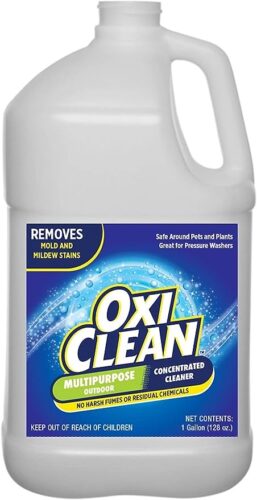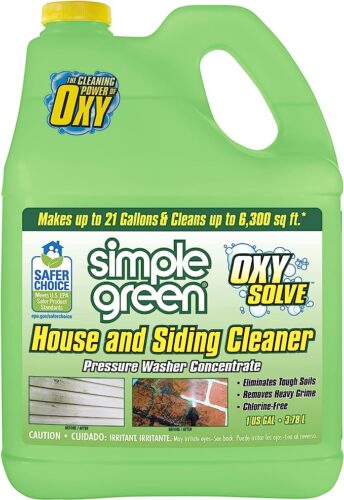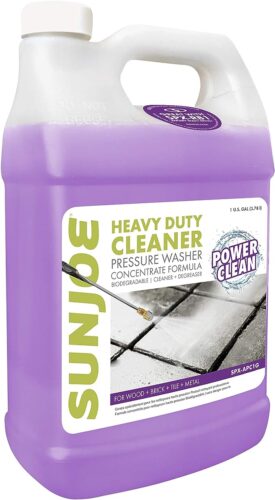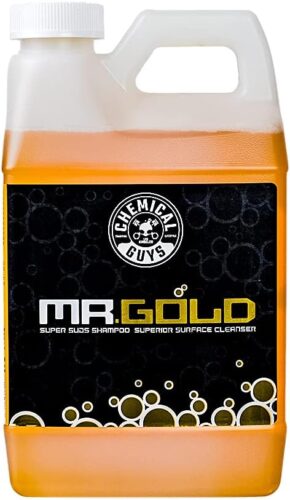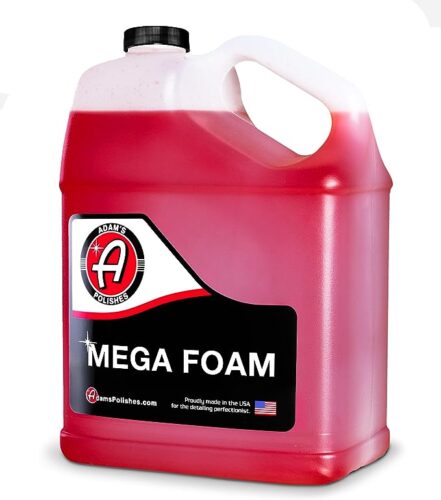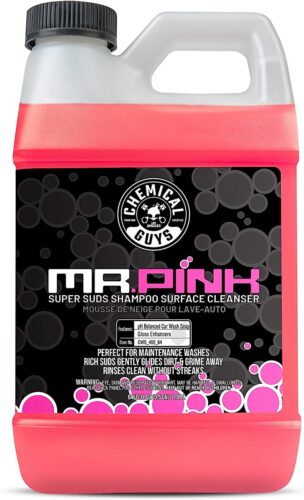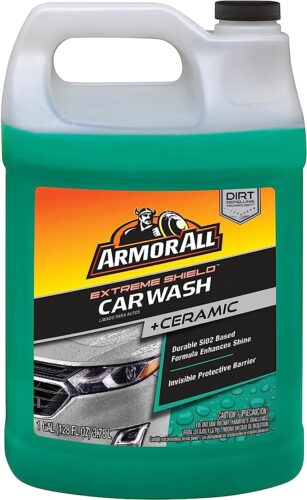Discover the transformative power of pressure washers with detergent, a dynamic duo that brings a multitude of benefits to your cleaning endeavors. In the realm of household chores and outdoor maintenance, the combination of a pressure washer with detergent proves to be an unparalleled force in tackling stubborn grime, dirt, and stains.
By harnessing the forceful spray of high-pressure water and coupling it with the cleaning prowess of specialized detergents, this dynamic duo not only saves you valuable time and effort but also delivers exceptional results on various surfaces. Whether you’re reviving grimy driveways, revitalizing weathered fences, or restoring the splendor of your home’s exterior, the symbiotic relationship between pressure washer and detergent promises to be a game-changer, ensuring a pristine and sparkling finish with every use.
Here we’ll be explaining how to use a pressure washer with detergent, taking you through the different types of detergents commonly found and how and when to use them.
Affiliate Disclosure: As a disclaimer, please note that some of the links included in this article are affiliate links. This means that if you click on one of these links and make a purchase, we may receive a small commission at no extra cost to you. We only recommend products or services that we believe can add value to our readers. Your support through these links is greatly appreciated and helps us to keep creating helpful content. As an Amazon Associate and affiliate, I earn from qualifying purchases.
Basic Types of Pressure Washer Detergents
High-pressure washers normally have detergents which are classified as either cleaners, sanitizers or disinfectants. Cleaners simply remove dirt and do not kill microorganisms. Sanitizers are rapid-acting cleaners which kill 99.99% of bacteria. Disinfectants kill all organisms; however, they take as long as 10 minutes to work. Make sure that your choice of detergent is biodegradable, and always get a cleaning agent which is specifically designed for your purpose. You don’t want to use a harsh detergent designed for cleaning concrete on the delicate paint of your car. This is fairly easy than sharpening your rage broadheads.
- Cleaners:
Cleaners are pressure washer detergents designed to remove dirt, grime, grease, and other surface contaminants. They are ideal for general cleaning tasks where killing microorganisms is not a primary concern. Cleaners are commonly used for cleaning surfaces like decks, patios, sidewalks, and fences. They help to restore the appearance of surfaces by removing built-up dirt and stains without any antimicrobial properties.
When You Would Use This: A general-purpose cleaner for pressure washers designed to remove stubborn dirt and stains from outdoor surfaces, such as a “Multi-Surface Cleaner.”
- Sanitizers:
Sanitizers are more powerful detergents that not only clean surfaces but also have the ability to kill a significant portion of bacteria and some other microorganisms. They are faster-acting than disinfectants but are not as strong in eradicating all types of germs. Sanitizers are often used in environments where maintaining a certain level of cleanliness is essential, such as in food preparation areas or public spaces.
When You Would Use This: A pressure washer sanitizer suitable for cleaning outdoor furniture, children’s play equipment, and other surfaces, such as a “Bacterial Sanitizer.”
- Disinfectants:
Disinfectants are the most potent types of pressure washer detergents, capable of killing almost all microorganisms, including bacteria, viruses, and fungi. They are used in situations where thorough sterilization is required to prevent the spread of infectious diseases. Disinfectants need sufficient contact time on the surface to be effective, usually around 10 minutes.
When You Would Use This: A heavy-duty pressure washer disinfectant designed for cleaning surfaces in medical facilities or high-risk areas, such as a “Hospital-Grade Disinfectant.”
- Biodegradable Detergents:
Regardless of the type (cleaner, sanitizer, or disinfectant), it is essential to choose a biodegradable detergent for pressure washing. Biodegradable detergents break down naturally over time and are less harmful to the environment. They also reduce the risk of contaminating nearby water sources or harming plants and animals.
When You Would Use This: An eco-friendly pressure washer detergent labeled as “Biodegradable All-Purpose Cleaner.”
- Purpose-Specific Detergents:
Always ensure that the pressure washer detergent you choose is specifically designed for the intended purpose and surface type. Using the wrong type of detergent can lead to damage or ineffective cleaning. For instance, using a harsh concrete cleaner on the delicate paint of a car can cause paint damage, and using a vehicle detergent on a wooden deck may not yield satisfactory results.
When You Would Use This: A pressure washer detergent specially formulated for cleaning vehicles, such as “Car Wash & Wax.”
Understanding the basic types of pressure washer detergents (cleaners, sanitizers, and disinfectants), opting for biodegradable options, and using purpose-specific cleaning agents will help you achieve optimal cleaning results while preserving the integrity of the surfaces you are washing.

My Top Pressure Washer Detergent Picks
Outdoor and Multipurpose Power Washer Detergents
Car and Vehicle Power Washing Detergents
Cleaning Using a Pressure Washer with Onboard Tank
Almost all high-pressure cleaners feature a separate detergent tank. When your cleaner has its own onboard detergent tank, all you need to do is follow the instructions to fill it with your choice of detergent. Don’t use an extension when using detergent and your pressure washer. Make sure that you check your instruction manual for the appropriate nozzle type before setting the pressure to low and switching it on. From a low setting, you can slowly adjust the pressure until you have a good visibility and density of soap suds forming.
Foamers and Cleaning Attachments
Foamers and cleaning attachments provide an alternative and effective way to apply detergent without running it through the pressure washer pump. These attachments are especially useful when you want to create a thick foam for cleaning tasks, such as washing vehicles or tackling stubborn dirt on various surfaces. Let’s explore these foamers and cleaning attachments in more detail:
- Foamers for Thick Foam Application:
Foamers are specialized attachments designed to produce a dense and clinging foam. Unlike running detergent through the pressure washer pump, foamers work at a lower pressure and temperature, optimizing the foam’s effectiveness. This thick foam clings to surfaces, allowing the detergent to dwell and work on lifting dirt and grime before rinsing.
When You Would Use This: When cleaning a car, a foamer attachment is ideal as it creates a luxurious foam that gently encapsulates and lifts dirt without causing scratches.
- Spray Nozzle Foamers with Siphoning Tube:
Some foamers use a spray nozzle connected to a tube that siphons detergent from a separate bucket. This setup allows you to easily switch between different detergents or adjust the detergent-to-water ratio as needed. It provides flexibility in using various cleaning agents for specific tasks.
When You Would Use This: For a car detailing business, a spray nozzle foamer with a siphoning tube enables quick and efficient switching between different car wash soaps, waxes, and other specialized cleaning solutions.
- High-Quality Foamers with Built-In Detergent Tanks:
Premium foamers come with built-in detergent tanks that attach to the foam spray gun. This design simplifies the process, as there’s no need for an external bucket or siphoning tube. The foam gun attachment features a valve that allows you to adjust the spray pattern, providing more control over the foam application.
When You Would Use This: When cleaning large areas like driveways or exterior walls, a high-quality foamer with a built-in detergent tank reduces downtime and enhances productivity.
- Soap Shooters with Siphoning Tube:
Soap shooters are similar to foamers but use a different design. They also employ a siphoning tube but require the user to dip the soap shooter directly into a container of the detergent mixture. Once the tube is filled with the cleaning solution, you can spray the area you’re cleaning.
When You Would Use This: When dealing with localized stains or spots on outdoor surfaces, a soap shooter allows for the precise application of detergent for spot-cleaning purposes.
Foamers and cleaning attachments provide practical alternatives to running detergent through the pressure washer pump. They create thick foams that efficiently break down dirt and grime, making the cleaning process more effective and enjoyable. Whether you choose a foamer with a spray nozzle and siphoning tube or invest in a high-quality foamer with a built-in detergent tank, these attachments offer versatility and convenience for various cleaning tasks. Consider your specific cleaning needs and the surfaces you’ll be working on to determine the most suitable foamer or cleaning attachment for your pressure washer.
Basic Cleaning Procedure
Cleaning with a pressure washer equipped with an onboard detergent tank is a convenient and efficient way to tackle tough dirt and grime on various surfaces. The integration of the detergent tank streamlines the process, eliminating the need for carrying separate containers or using external siphoning systems. Here’s a step-by-step guide with examples on how to effectively clean using a pressure washer with an onboard tank:
- Fill the Detergent Tank:
The first step is to fill the onboard detergent tank with the appropriate pressure washer detergent. Different detergents are designed for various cleaning tasks. For example, if you’re cleaning a deck, you can use a wood cleaner formulated to remove mildew, mold, and stains from wood surfaces. If you’re cleaning a car, you can use a specialized car wash detergent that won’t harm the paint or wax. Always follow the manufacturer’s instructions for dilution ratios and usage guidelines.
When You Would Use This: If you are cleaning a concrete driveway, you might use a powerful concrete cleaner that can dissolve oil stains and remove ground-in dirt effectively.

- Avoid Using Extensions:
When using the detergent function of your pressure washer, it’s essential not to use any extensions or attachments on the spray wand. Extensions can interfere with the proper mixing of detergent and water, leading to ineffective cleaning results. Instead, use the standard spray wand directly attached to the pressure washer’s gun.
When You Would Use This: If you’re cleaning a heavily soiled outdoor grill, remove any attachments from the spray wand to ensure the detergent is evenly mixed and applied.
- Check the Instruction Manual for Nozzle Type:
Before you begin cleaning, check the pressure washer’s instruction manual to find the appropriate nozzle type for using detergent. Some pressure washers come with specific nozzles or attachments designed for applying detergent effectively. This nozzle usually has a wider spray pattern to evenly distribute the soap over the surface.
When You Would Use This: If you’re cleaning a brick wall, make sure you are using the nozzle specifically designed for applying detergent to ensure even coverage.
- Set the Pressure to Low:
When you’re ready to start cleaning with detergent, set the pressure washer to the lowest setting. The lower pressure allows the detergent to penetrate and loosen dirt and grime effectively without causing damage to more delicate surfaces. This is especially important when cleaning vehicles or painted surfaces.
When You Would Use This: If you’re cleaning a wooden fence, start with the pressure set to low to avoid damaging the wood fibers.
- Gradually Increase Pressure:
With the pressure washer running on the low setting, apply the detergent to the surface. Move the spray wand slowly and steadily, ensuring thorough coverage. As you see soap suds forming, you can gradually increase the pressure to enhance the cleaning power.
When You Would Use This: When cleaning a concrete patio, slowly increase the pressure until you find the optimal balance between effective cleaning and avoiding surface damage.
By following these steps and considering the specific examples provided, you can achieve efficient and successful cleaning results using a pressure washer with an onboard detergent tank. Always prioritize safety, read the manufacturer’s guidelines, and choose the right detergent for the task at hand to achieve the best possible outcome.
Mixing Your Pressure Washer Own Solution
Many users prefer to stick to car wash detergents that they are used to. The problem lies in the fact that most of these detergents are supplied for hand-washing purposes, and a degree of conversion will be needed to find out how much you need to fill your tank with. You can work on a measurement of roughly 2.5 gallons per bucket and the average 10-minute car wash uses a maximum of 10 buckets of water. Based on this relative measure, you can quickly work out how much hand wash detergent you need in your detergent tank.
A Plant-Safe Detergent for Pressure Washers
When cleaning outside you can always resort to vinegar for a plant-safe cleaning solution. Mix 3 parts white vinegar to 7 parts water and put this in your detergent tank. This mix is not dangerous to plants or insects and it helps eliminate mold and mildew as you wash.
Avoid Bleach Solutions in Pressure Washers
Bleach contains a highly corrosive compound called sodium hypochlorite which is so damaging that many pressure washer manufacturers void the warranty of the unit as soon as it is used. Regardless of which washer you have, rather steer clear of bleach and bleach-based solutions to prolong the lifespan of your pressure washer.
Pressure Washer Preparations
When cleaning with a pressure washer always prepare the area by protecting walls and doors, sweeping surfaces clear of excess dirt and debris, and utilize the proper cleaning agent for the job. If degreasing is needed, degrease first, then attach the spray wand tip for detergent.
A foamer gets the job done quickly. Always give your detergent some time to sit and work away at the grime before rinsing it off with a wider spray. Not every scenario will require detergent but don’t underestimate the value. Every good high-pressure washer must feature a detergent tank as its cleaning power is invaluable when properly utilized.
FAQ about Pressure Washing
Q: What is pressure washing?
A: Pressure washing, also known as power washing, is a cleaning method that utilizes high-pressure water to remove dirt, grime, mold, mildew, and other contaminants from surfaces. It is commonly used for cleaning outdoor areas like driveways, decks, siding, fences, and vehicles.
Q: How does a pressure washer work?
A: A pressure washer consists of a motor or engine that powers a pump, which pressurizes water from a garden hose. The high-pressure water is then delivered through a wand or nozzle, allowing users to direct the focused stream onto surfaces for effective cleaning.
Q: What surfaces can I clean with a pressure washer?
A: Pressure washers are versatile and can clean various surfaces, including concrete, wood, brick, stone, metal, vinyl siding, and vehicles. However, some delicate surfaces may require lower pressure or specific cleaning attachments to avoid damage.
Q: Is pressure washing safe for all surfaces?
A: While pressure washing is generally safe for many surfaces, it can cause damage if used improperly. High pressure can strip paint, etch wood, or chip away at delicate materials. It’s essential to follow the manufacturer’s guidelines and use the appropriate pressure, nozzles, and detergents for each surface.
Q: Can pressure washing remove tough stains?
A: Yes, pressure washing is effective at removing tough stains, such as oil, grease, algae, and mildew. The high-pressure water, combined with suitable detergents, can break down and lift stubborn stains from various surfaces.
Q: Can pressure washing damage my home?
A: When used correctly, pressure washing should not damage your home. However, using too much pressure, holding the nozzle too close to the surface, or using the wrong nozzle can cause damage. It’s crucial to be cautious and start with low pressure, especially on delicate surfaces.
Q: Can I use a pressure washer indoors?
A: Pressure washers are designed for outdoor use due to the high-pressure water output. Using a pressure washer indoors can lead to water damage and safety hazards. However, some pressure washers have low-pressure settings suitable for indoor use on specific surfaces.
Q: Do I need to use detergent with a pressure washer?
A: While plain water can remove some dirt and debris, using detergent can enhance the cleaning process significantly. Detergents designed for pressure washers can break down tough stains and improve overall cleaning results.
Q: How often should I pressure wash my home?
A: The frequency of pressure washing depends on various factors, such as the climate, location, and level of dirt and grime buildup. Generally, homes should be pressure washed once a year, but more frequent cleaning might be necessary in areas with high humidity or heavy pollution.
Q: Can I pressure wash my car?
A: Yes, pressure washing is suitable for cleaning cars, but it’s essential to use a low-pressure setting and a car-friendly detergent. Avoid using high pressure near sensitive components or loose parts that might get damaged.
Conclusion
Pressure washers with detergent tanks offer versatile cleaning options for a variety of tasks. Choose the right type of detergent, opt for biodegradable options, and follow proper cleaning procedures for optimal results. Foamers and cleaning attachments can enhance the cleaning process, while preparing the area and using the correct cleaning agent are essential. Overall, pressure washers with detergent tanks are valuable tools for effective and efficient cleaning.

